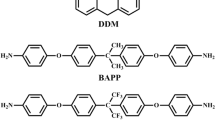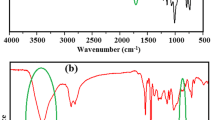Abstract
Acrylicpimaric acid-based epoxy (APA-based epoxy) and tung oil maleic anhydride (TMA), as a curing agent, were synthesized and used to prepare fully bio-based cured epoxies. The chemical structure was characterized by FTIR and 1H NMR spectroscopy techniques. The effects of using APA-based epoxy to replace DER332 epoxy were investigated. The curing behavior, dynamic mechanical properties, mechanical properties, thermal stability and fracture surface were studied using differential scanning calorimetry (DSC), dynamic mechanical analysis (DMA), a universal testing machine, thermogravimetric analysis (TGA) and scanning electron microscope (SEM). The activation energy (Ea) of the curing process of the APA-based epoxy with TMA was 69.45 kJ/mol, which was almost the same as the Ea of the curing of DER332 process with TMA. Because of the rigidity of the hydrogen phenanthrene ring structure in the APA-based epoxy was higher than that of bisphenol A structure in DER332, the glass transition temperature (Tg) of the cured APA-based epoxy was 21 °C higher than that of the cured DER332 epoxy. The tensile strength, Young’s modulus and the peak temperature of the weight loss rate (Tmax) of cured APA-based epoxy were higher than those of the cured DER332 epoxy. With a decrease in the APA-based epoxy content, the fracture surfaces of the cured APA-epoxy were much rougher. The cured APA-based epoxy exhibited higher storage modulus and Young’s modulus than the cured resins that were formed from flexible monomers. Therefore, the APA-based epoxy showed great potential to replace DER322 epoxy in preparing cured epoxies.










Similar content being viewed by others
References
Schneiderman D, Hillmyer M (2017) 50th Anniversary perspective: there is a great future in sustainable polymers. Macromolecules 50:3733–3749
Gandini A, Lacerda T, Carvalho A, Trovatti E (2016) Progress of polymers from renewable resources: furans, vegetable oils, and polysaccharides. Chem Rev 116:1637–1669
Huang J, Yuan T, Ye X, Man L, Zhou C, Hu Y, Zhang C, Yang Z (2018) Study on the UV curing behavior of tung oil: mechanism, curing activity and film-forming property. Indust Crops Prod 112:61–69
Iwata T (2015) Biodegradable and bio-based polymers: future prospects of eco-friendly plastics. Angew Chem Int Ed Engl 54:3210–3215
Wang Z, Yuan L, Ganewatta M, Lamm M, Rahman M, Wang J, Liu S, Tang C (2017) Plant oil-derived epoxy polymers toward sustainable biobased thermosets. Macromol Rapid Commun 38:1700009
Guo L, Yang X, Dong F, Qian Y, Guo J, Lin X, Shaghaleh H, Liu W, Xu X, Wang S, Liu S (2020) A pinene-based silane crosslinker for improved mechanical strength/transparency of room-temperature vulcanizing silicone rubber. Mater Chem Phys 247:122868
Qian Y, Dong F, Guo L, Guo J, Shaghaleh H, Wang Y, Xu X, Wang S, Liu S (2020) Preparation and properties of room temperature vulcanized silicone rubber using triethoxy(2-(4-methylcyclohex-3-en-1-yl)propyl)silane as a novel cross-linking agent. Polym Degrad Stabil 173:109068
Gandini A, Lacerda T, Carvalho A (2013) A straightforward double coupling of furan moieties onto epoxidized triglycerides: synthesis of monomers based on two renewable resources. Green Chem 15:1514–1519
Huang K, Zhang P, Zhang J, Li S, Li M, Xia J, Zhou Y (2013) Preparation of biobased epoxies using tung oil fatty acid-derived C21 diacid and C22 triacid and study of epoxy properties. Green Chem 15:2466–2475
Baroncini EA, Kumar Yadav S, Palmese GR, Stanzione JF (2016) Recent advances in bio-based epoxy resins and bio-based epoxy curing agents. J Appl Polym Sci 45:44103
Thiele K, Eversmann N, Krombholz A, Pufky-Heinrich D (2019) Bio-based epoxy resins based on linseed oil cured with naturally occurring acids. Polymers (Basel) 11:1409
Huang X, Yang X, Liu H, Shang S, Cai Z, Wu K (2019) Bio-based thermosetting epoxy foams from epoxidized soybean oil and rosin with enhanced properties. Indust Crop Prod 139:111540
Huang K, Liu Z, Zhang J, Li S, Li M, Xia J, Zhou Y (2014) Epoxy monomers derived from tung oil fatty acids and its regulable thermosets cured in two synergistic ways. Biomacromol 15:837–843
Sahoo SK, Khandelwal V, Manik G (2018) Development of completely bio-based epoxy networks derived from epoxidized linseed and castor oil cured with citric acid. Polym Adv Technol 11:2080–2090
Altuna FI, Espósito LH, Ruseckaite RA, Stefani PM (2011) Thermal and mechanical properties of anhydride-cured epoxy resins with different contents of biobased epoxidized soybean oil. J Appl Polym Sci 120:789–798
Mauck JR, Yadav SK, Sadler JM, La Scala JJ, Palmese GR, Schmalbach KM, Stanzione JF (2017) Preparation and characterization of highly bio-based epoxy amine thermosets derived from lignocellulosics. Macromol Chem Phys 218:1700013
Nikafshar S, Zabihi O, Hamidi S, Moradid Y, Barzegara S, Ahmadi M, Naebe M (2017) A renewable bio-based epoxy resin with improved mechanical performance that can compete with DGEBA. RSC Adv 7:8694–8701
Chen CH, Tung SH, Jeng RJ, Abu-Omar M, Lin CH (2019) A facile strategy to achieve fully bio-based epoxy thermosets from eugenol. Green Chem 21:4475–4488
Feghali E, van de Pas DJ, Parrott AJ, Torr KM (2020) Biobased epoxy thermoset polymers from depolymerized native hardwood lignin. ACS Macro Lett 9:1155–1160
Zhao XL, Liu YY, Weng Y, Li YD, Zeng JB (2020) Sustainable epoxy vitrimers from epoxidized soybean oil and vanillin. ACS Sustain Chem Eng 8:15020–15029
Zhang H, Jiang J, Shang S, Song Z, Song J (2018) Novel, rosin-based, hydrophobically modified cationic polyacrylamide for kaolin suspension flocculation. J Appl Polym Sci 135:46637
Wilbon P, Chu F, Tang C (2013) Progress in renewable polymers from natural terpenes, terpenoids, and rosin. Macromol Rapid Commun 34:8–37
Yao K, Tang C (2013) Controlled polymerization of next-generation renewable monomers and beyond. Macromolecules 46:1689–1712
Ma Q, Liu X, Zhang R, Zhu J, Jiang Y (2013) Synthesis and properties of full bio-based thermosetting resins from rosin acid and soybean oil: the role of rosin acid derivatives. Green Chem 15:1300–1310
Li Q, Huang X, Liu H, Shang S, Song Z, Song J (2017) Properties enhancement of room temperature vulcanized silicone rubber by rosin modified aminopropyl triethoxysilane as a cross-linking agent. ACS Sustain Chem Eng 5:10002–10010
Lu L, Qiu Y, Xiong Z, Guo X, Wang C, Wang J, Chu F (2020) Combination of atom transfer radical polymerization and click chemistry toward cellulose-rosin derived UV-absorbent copolymers. Iran Polym J 29:975–983
Li Z, Yang X, Liu H, Yang X, Shan Y, Xu X, Shang S, Song Z (2019) Dual-functional antimicrobial coating based on a quaternary ammonium salt from rosin acid with in vitro and in vivo antimicrobial and antifouling properties. Chem Eng J 37:4564–4575
Liu B, Nie J, He Y (2016) From rosin to high adhesive polyurethane acrylate: synthesis and properties. Int J Adhes Adhes 66:99–103
Zhang Z, Du J, Zhang D, Sun H, Yin L, Ma L, Chen J, Ma D, Cheng H, Ren W (2017) Rosin-enabled ultraclean and damage-free transfer of graphene for large-area flexible organic light-emitting diodes. Nat Commun 8:14560
Yang X, Guo L, Xu X, Shang S, Liu H (2020) A fully bio-based epoxy vitrimer: self-healing, triple-shape memory and reprocessing triggered by dynamic covalent bond exchange. Mater Des 186:108248
Liu X, Xin W, Zhang J (2009) Rosin-based acid anhydrides as alternatives to petrochemical curing agents. Green Chem 11:1018–1025
Thakur T, Jaswal S, Parihar S, Gaur B, Singha A (2020) Bio-based epoxy thermosets with rosin derived imidoamine curing agents and their structure–property relationships. Exp Polym Lett 14:512–529
Brocas AL, Llevot A, Mantzaridis C, Cendejas G, Auvergne R, Caillol S, Carlotti S, Cramail H (2014) Epoxidized rosin acids as co-precursors for epoxy resins. Des Monom Polym 17:301–310
Li T, Liu X, Jiang Y, Ma S, Zhu J (2016) Bio-based shape memory epoxy resin synthesized from rosin acid. Iran Polym J 25:1–9
Huang K, Zhang J, Li M, Xia J, Zhou Y (2013) Exploration of the complementary properties of biobased epoxies derived from rosin diacid and dimer fatty acid for balanced performance. Indust Crop Prod 49:497–506
Li C, Liu X, Zhu J, Zhang C, Guo J (2013) Synthesis, characterization of a rosin-based epoxy monomer and its comparison with a petroleum-based counterpart. J Macromol Sci Part A Chem 50:321–329
Deng L, Ha C, Sun C, Zhou B, Yu J, Shen M, Mo J (2013) Properties of bio-based epoxy resins from rosin with different flexible chains. Indust Eng Chem Res 52:13233–13240
Xin J, Li M, Li R, Wolcott M, Zhang J (2016) Green epoxy resin system based on lignin and tung oil and its application in epoxy asphalt. ACS Sustain Chem Eng 4:2754–2761
Ozawa T (1970) Kinetic analysis of derivative curves in thermal analysis. J Therm Anal 2:301–324
Yuan L, Wang Z, Trenor N, Tang C (2015) Robust amidation transformation of plant oils into fatty derivatives for sustainable monomers and polymers. Macromolecules 48:1320–1328
Chakma P, Konkolewicz D (2019) Dynamic covalent bonds in polymeric materials. Angew Chem Int Ed Engl 58:9682–9695
Mantzaridis C, Brocas AL, Llevot A, Cendejas G, Auvergne R, Caillol S, Carlotti S, Cramail H (2013) Rosin acid oligomers as precursors of DGEBA-free epoxy resins. Green Chem 15:3091–3098
El-Ghazawy RA, El-Saeed AM, Al-Shafey HI, Abdul-Raheim ARM, El-Sockary MA (2015) Rosin based epoxy coating: synthesis, identification and characterization. Eur Polym J 69:403–415
Liu T, Tjiu WC, Tong Y, He C, Goh SS (2010) Morphology and fracture behavior of intercalated epoxy/clay nanocomposites. J Appl Polym Sci 94:1236–1244
Atta AM, Mansour R, Abdou MI, El-Sayed AM (2005) Synthesis and characterization of tetra-functional epoxy resins from rosin. J Polym Res 12:127–138
Acknowledgements
We acknowledge the support from Jiangsu Key Laboratory for Biomass Energy and Materials (JSBEM-S-201907), National Natural Science Foundation of China (31901261) and Discipline group construction project of CAF-ICIFP (LHSXKQ1).
Author information
Authors and Affiliations
Corresponding author
Rights and permissions
About this article
Cite this article
Zhang, H., Li, W., Xu, J. et al. Synthesis and characterization of bio-based epoxy thermosets using rosin-based epoxy monomer. Iran Polym J 30, 643–654 (2021). https://doi.org/10.1007/s13726-021-00918-9
Received:
Accepted:
Published:
Issue Date:
DOI: https://doi.org/10.1007/s13726-021-00918-9




